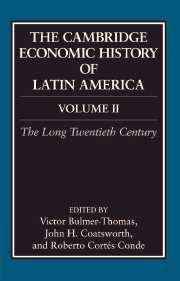Book contents
- Frontmatter
- Introduction
- Part I Cycles of Globalization
- Part II Onset of Modernization
- Part III Factor Endowments
- Part IV Sectoral Development and Equity
- 12 Structure, Performance, and Policy in Agriculture
- 13 The Political Economy of Industrialization
- 14 Poverty and Inequality
- Bibliographical Essays
- Index
- References
12 - Structure, Performance, and Policy in Agriculture
from Part IV - Sectoral Development and Equity
Published online by Cambridge University Press: 28 March 2008
- Frontmatter
- Introduction
- Part I Cycles of Globalization
- Part II Onset of Modernization
- Part III Factor Endowments
- Part IV Sectoral Development and Equity
- 12 Structure, Performance, and Policy in Agriculture
- 13 The Political Economy of Industrialization
- 14 Poverty and Inequality
- Bibliographical Essays
- Index
- References
Summary
Agriculture is the most important and basic human economic activity. Without food, life is not possible. Yet, paradoxically, as a country develops, the economic importance of agriculture diminishes and its contribution to the Gross National Product (GNP) is reduced. This is because the income elasticity of demand for agricultural products is low. Once people have satisfied their basic needs, their attention moves to the satisfaction of other wants. Yet, as an economy develops, the productivity of agriculture increases, lowering the costs of production and freeing labor that moves to the industry and service sector.
A corollary of this fact is that a high contribution of agriculture to GNP implies a low level of development. However, agriculture can be the motor that energizes the economy. A modern agriculture, in contrast with traditional farming, has many linkages with industry, both as a user of industrial products (e.g., fertilizers, machinery, and agrochemicals) and as a source of materials for industrial enterprises (e.g., fibers, raw food products, and industrial oils). Modern agriculture is also a consumer of services (e.g., banking, transport, and research). Few countries have developed without developing first a strong agrarian base.
Latin American agriculture is very heterogeneous, reflecting the enormous diversity of landscapes, climates, soils, and local circumstances. Yet, there are some common features. The first and most striking is the importance of agriculture in the economies of Latin America. Since colonial times, the region has depended on agriculture and livestock as major sources of exports and employment. A second feature is the uneven allotment of land, the well-known latifundio-minifundio distribution.
- Type
- Chapter
- Information
- The Cambridge Economic History of Latin America , pp. 481 - 536Publisher: Cambridge University PressPrint publication year: 2006
References
- 1
- Cited by



